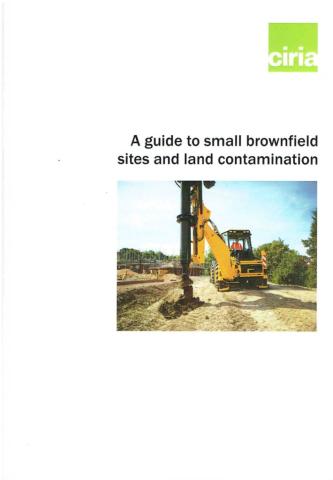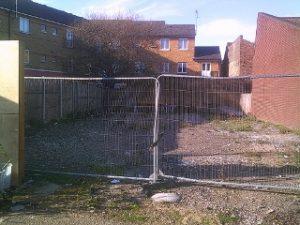Cost Effective Vapour & Land Gas Monitoring in Confined Spaces
Do you need to undertake vapour or land gas monitoring in a confined space or need to keep disruption to a minimum then we may have the answer. We are now able to undertake land gas and vapour monitoring using Vapor PinsTM.
The system is relatively quick and easy to install and is a very cost effective method of vapour and land gas monitoring. In difficult to access basements it may be the only practicable option, it could literally be installed in a broom cupboard.
The system is installed in a 16mm diameter hole drilled through a ground or basement level slab and can be recessed to be flush with the floor with a protective cover so that the area can continue to be used. Installation of three monitoring points can usually be completed in a matter of hours.
Watch our installation video.

Novel Japanese Knotweed Treatment
Rootwave have devised a very different way of tacking invasive weeds.
While clearly not the answer in every case it will no doubt have its uses. If this is something from which you are suffering then perhaps this product which uses electricity to “boil weeds inside out from the root upwards” may be the answer.

PFAS Concerns in Australia
In Australia a joint parliamentary committee has been investigating contamination from toxic firefighting chemicals which leached off defence bases and into soil and waterways. A Guardian article states that they have produced a report recommending the government “assist property owners and businesses in affected areas for demonstrated, quantifiable financial losses associated with PFAS contamination that has emanated from defence bases”.
states that they have produced a report recommending the government “assist property owners and businesses in affected areas for demonstrated, quantifiable financial losses associated with PFAS contamination that has emanated from defence bases”.
Is this something we should addressing in the UK?
Soil Guideline Value (SGV) for mercury withdrawn
The Environment Agency (EA) has withdrawn the Soil Guideline Value (SGV) for mercury and the associated supporting reports. This follows discussions with Public Health England (PHE) about a revised opinion from the European Food Safety Authority (EFSA). EFSA recommended an oral TDI for both these forms of mercury that are lower than the oral HCV used in the derivation of the SGV.
The EA advised “We are withdrawing our reports in light of this expert opinion. We will not be updating them as the Environment Agency no longer undertakes work to derive new SGV or TOX reports, but we will continue to recommend that relevant public health bodies are consulted where industry has published or is developing alternative guideline criteria for mercury which would also include elemental mercury.”
The SGV Report, the TOX Report, and the Supporting Information Document for Mercury will remain available for historical reference on the Government and Environment Agency archives and on the CL:AIRE WALL
In 2012, EFSA published their scientific opinion on the public health risk from the presence of inorganic mercury and methylmercury in food. The full report is available here: https://www.efsa.europa.eu/en/efsajournal/pub/2985.
South East Property Expo
We had a great day at the South East Property Expo
and for anyone who did not manage to get along we have made a 30 second compilation of the action.
First Aid at Work
Congratulations to four members of staff, Davina, Daria, Jo and Deppie
on passing their three day First Aid at Work course and exam.

An End to Unnecessary Pre-Commencement Conditions?
A necessary evil or an unnecessary evil, whatever your view, planning conditions are part and parcel of the challenges of development. From the 1st October, an update to the Town and Country Planning Act may help to ease the pain, it will make it mandatory for Local Planning Authorities (LPAs) to liaise with applicants over the wording of pre-commencement conditions. Whilst it may not have gained as much publicity as the revised NPPF, this small legislative change is still a potentially significant shift in the operation of the planning process.
These changes mean that a LPA will be required to provide an applicant with the suggested pre-commencement conditions prior to determining an application. Applicants must be given at least 10 working days to provide a “substantive response”, only after this can an application be determined.
Potentially, great news for developers and applicants who will now hopefully be given a meaningful say in the drafting of pre-commencement conditions. Planning officers are only human like the rest of us and under pressure mistakes are sometimes made. This should stop drafting errors, duplicates or wrong conditions being imposed on planning consents that all result in delays to delivery. Contaminated land conditions, with their multiple stages seem particularly vulnerable to confusion as to what can reasonably be undertaken pre-commencement. It is also hoped that this will rationalise the pre-commencement conditions thereby saving time and money.
There are potential benefits for LPAs as it forces a review of standard pre-commencement conditions to ensure they are still; necessary, enforceable, precise and reasonable, it should also help to speed up decision making. LPAs will need to review their standard conditions and put procedures in place to ensure that applicants are given notice of proposed pre-commencement conditions in a timely manner.
These legislative changes will have to be factored into determination timeframes and it would be prudent of applicants to ask for conditions early (if possible) to avoid last minute delays. If you are an applicant or agent, it may be worthwhile contacting planning officers to confirm they are aware of this change to avoid any surprises.
We welcome this change, however, only time will tell whether this will become just another tick the box exercise or whether this will facilitate meaningful dialogue about the suitability of pre-commencement conditions, reduce the number of pre-commencement conditions and ultimately speed up delivery.
While the Government’s intention was to reduce the time lag between grant of planning permission and site start, will the law of unintended consequences mean that it will simply delay the issue of the planning permission?
A guide to small brownfield sites and land contamination
We have been please to both sponsor this guide and to take an active part in the steering group, guiding development of the guide, described by CIRIA as “essential reading for anyone who doesn’t routinely develop brownfield sites, or for those who are up-scaling into small developments”.
Our hope is that this guide will help all those involved in smaller brownfield projects to make realistic appraisals of the risks and to the avoid the potential pitfalls of potentially contaminated sites. It is written in plain English to ensure it can be used by anyone, there are of course some technical words but for instance words like “pre-acquisition ” have been dropped in favour of “before you buy”.
The chapters deal with:
The Project Team
Before Buying a Small Brownfield Site
The Planning Application
Preparing for Building Works
Construction
Closeout
A flow chart picks out the key issues to be managed at each of the above stages.
There is a launch event on 4 October at CIRIA’s London office

Contaminated Land Identified as Environmental Factor Most Likely to Cause Upset to a Housing Development
A recent survey by Development+Infrastructure identified contaminated land as the environmental factor most likely to cause upset to a housing development, followed by flood risk, more details here.
Once again it shows that the importance of taking advice at the earliest stage cannot be over stated. As my grandmother used to say, forewarned is forearmed.
Builders Shun Brownfield Sites to Dig up Green Belt – The Times 12 December 2017
An article in The Times declares that research by the Campaign to Protect Rural England (CPRE) shows that sites with the capacity for nearly 200,000 homes are missing from the official Brownfield Registers. With limited resources local authorities tend to concentrate on the larger sites, meaning that this vital resource of smaller sites is overlooked.
We have extensive experience of providing advice on small sites and are on the steering group for the CIRIA small brownfield sites report, which is due to be published shortly with advice on developing small brownfield sites.
We provide comprehensive support to guide clients through the process of obtaining discharge of contaminated land planning conditions, if you are considering buying or developing a small brownfield site do not hesitate to call 020 8291 1354 or askgo@gosolve.co.uk.
